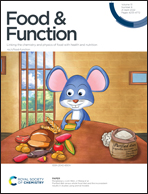Retracted Article: Targeting gut microbiota-derived butyrate improves hepatic gluconeogenesis through the cAMP-PKA-GCN5 pathway in late pregnant sows†
Abstract
Short chain fatty acids (SCFAs) produced by gut microbiota affected hepatic glucose metabolism via the gut–liver axis. The present study aimed to investigate the effects of butyrate produced by gut microbiota on hepatic gluconeogenesis in late-pregnancy sows. A total of 240 primiparous sows in late pregnancy were tested for blood glucose using a glucose meter before feeding and grouped according to their blood glucose level as follows: 0–3.0 mmol L−1 (low blood glucose group, LG group) and 3.1–5.0 mmol L−1 (normal blood glucose group, NG group). Colonic SCFAs and microbiota, SCFAs in the portal vein and liver, and acetylation and phosphorylation levels in the liver samples were analyzed. Hepatocytes from pregnant sows were examined for the effect of butyrate on hepatic glucose gluconeogenesis. In vivo experiments showed that the reproductive performance, serum glucose metabolism index, colonic butyrate and butyrate-producing bacteria decreased in the LG group compared with the NG group. Correlation analysis found a positive correlation among colonic butyrate, butyrate-producing bacteria and the serum glucose metabolism index. Moreover, the hepatic cAMP concentration, PKA activity, GCN5 phosphorylation, and the expression of G6P and PEPCK were decreased and PGC1-α acetylation was increased in the LG group compared with the NG group. In vitro, sodium butyrate significantly stimulated the cAMP concentration, PKA activity, GCN5 phosphorylation, and the expression of G6P and PEPCK and inhibited PGC-1α acetylation in the LG group of hepatocytes from late-pregnancy sows. Interestingly, another in vivo experiment showed that dietary 1-kestose, a natural regulator of gut bacteria, significantly increased butyrate and butyrate-producing bacteria, and improved the reproductive performance and serum glucose metabolism index in late-pregnancy sows. Taken together, we found that targeting gut microbiota-derived butyrate could improve hepatic gluconeogenesis through the cAMP-PKA-GCN5 pathway in late-pregnancy sows.

- This article is part of the themed collection: Food & Function HOT Articles 2022


 Please wait while we load your content...
Please wait while we load your content...